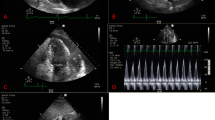Abstract
Purpose
Purulent pericarditis has become a rare disease since the introduction of antibiotics into clinical practice. Standard management consists of antibiotics and surgical drainage. In this study we also instilled streptokinase to obliterate the loculations and fibrin strands in patients with purulent pericarditis.
Methods
Between October 1997 and October 2002, we treated nine children with purulent pericarditis by pericardial drainage with streptokinase instillation and antibiotics. There were five boys and four girls aged between 3 and 13 years, with a mean age of 6.7 ± 2.9 years.
Results
Pericardiocentesis revealed purulent effusion of 180–650 ml in the pericardial space in all patients. Blood pressure increased and central venous pressure decreased after the pericardial empyema was evacuated in all patients. None of the patients had systemic bleeding, arrhythmias, or hypotension suggesting an anaphylactic reaction.
Conclusion
We found intrapericardial streptokinase to be safe and effective for dissolving fibrin layers and removing loculations, resulting in complete pericardial drainage. Therefore, intrapericardial streptokinase should be instilled to prevent constrictive pericarditis.
Similar content being viewed by others
Author information
Authors and Affiliations
Rights and permissions
About this article
Cite this article
Ekim, H., Demirbağ, R. Intrapericardial Streptokinase for Purulent Pericarditis. Surg Today 34, 569–572 (2004). https://doi.org/10.1007/s00595-004-2773-x
Received:
Accepted:
Issue Date:
DOI: https://doi.org/10.1007/s00595-004-2773-x




